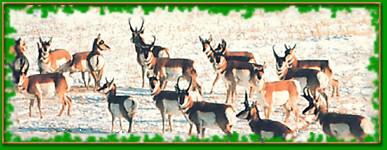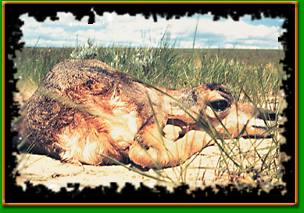 |
By Ed Hofman History and Background First, let's set the record straight by saying that the animal most people know, throughout it's range, as the "pronghorn antelope" is definitely not an antelope! It belongs in a Family (Antilocapridae) all by itself and has no other close, living relatives; it is not related at all to the "antelopes" of Africa. From now on, I will refer to this animal strictly as the "pronghorn".
Pronghorns in Alberta are at the extreme northern limit of their range in North America, found in wide, flat, open areas where they can see their enemies from a long way off. Their range is from Mexican prairie and wasteland areas and western North America north to southern Canada, where we find them here in Alberta. In this area, they are subject to the extreme influences of climate and local weather and populations often fluctuate dramatically from one year to the next. Over the decades, their numbers have ranged from less than 2,000 animals during the early 1900's (particularly the severe winter of 1906-07) and 1932 (est. 1,900 animals) to over 30,000 in 1945 and 32,000 in 1984. Between those years, pronghorn numbers were "all over the map". In virtually every case, the causes for the oscillations were the direct result of extremes in the climatic characteristics of primarily snow depth, drought and temperature. After a mild winter, pronghorn populations responded by increasing as much as 90% in one year (1962/63-1963/64). Conversely, after a particularly severe winter, populations declined by almost as much (1965-66). This does not mean that declines were attributed to mortality alone, as we know that many animals left Alberta for the more moderate climes of Montana during harsh winter storms here. Climate and Weather: The climate typical of pronghorn range in Alberta is characterized by low annual precipitation, extremes in annual seasonal temperature, periods of extended drought and generally high rates of evaporation (cool, semi-arid ecoregion). Average precipitation at Brooks over a 30 year period (1931-1960) was 345 mm, with average snow depth accumulations (Sept. to May) of between 43 and 190 cm during the early 1960's. The mean annual temperature during the same period and same area was 3.9 degrees C, with extremes ranging from a low of - 43 degrees C to a high of +41 degrees C. The occurrence of a phenomenon known as "Chinooks" (strong, warm, westerly or southwesterly winds) often reduced the negative effects of a severe winter on pronghorns. However, the same winds prevalent during the summer months have the effect of desiccating the landscape and reducing vegetative mass (reduction of quantity and quality of food sources going into the winter). Natural History and Biology:Nutrition - Tall, woody vegetation in pronghorn range is limited primarily to riparian areas of rivers, streams, flood plains, coulees, draws, breaks and drainages. Elsewhere, the dominant vegetation types are grasses and small woody shrubs, both of which are essential to pronghorn existence. Silver Sage (Artemesia cana), Salt Sage (Atriplex nuttalli), Western Snowberry (Symphoriocarpus occidentalis), Prickly Rose (Rosa acicularis), Buffalo Berry (Shepherdia argentea) and various species of Willow (Salix spp.) found on pronghorn winter range all contribute to the survival of pronghorns in Alberta, and make up over 40% of the fall and winter diet. Grasses (25%), forbes (50%) and sedges make up the bulk of the spring and summer food items. Common species of these are Pasture Sage (Artemesia frigida), Western Wheatgrass (Agropyron smithii), June Grass (Koeleria gracilis), Blue Grama Grass (Bouteloua gracilis), Spear Grass (Stipa comata), and Sandberg Bluegrass (Poa secunda). Appearance - Pronghorns are small animals measuring only 85 - 90 cm (less than 3 feet) at the shoulder. Males have the characteristic black "cheek patch" which is evident from birth and which is totally lacking in females. Males also have horns (they are not "antlers"!) which are much more developed than they are in females, though many females exhibit small horns covering a small bony "core". These horns are unique to pronghorns and are what gives them their name. Horns typically curl at the tip, and have a "prong" pointing forward and upward usually about midway from the base to the tip. The horn "sheath" (and not the bony core) is shed annually (like typical antlers of members of the deer Family) in late fall (late October or early November), making it important for hunting seasons to be over by then. Mature males weigh an average of 56 kg (123 lb), mature females 50 kg (110 lb), yearling males 51 kg, yearling females 44 kg, and newborn kids weigh about 4 kg (9 lb).
The "calving" or birthing season normally takes place in late May. The gestation period for pronghorns is about 250 days, so with breeding and conception taking place in September or October the kids are typically born between May 23 and 30. Twins are the rule, rather than the exception, with up to 65% of mature females bearing twins; triplets are also not uncommon, though "single" births are more frequent. Kids can walk and nurse within an hour of their birth, and are remarkably mobile in about two or three days. They remain bedded some distance away from the mother 90% of the time for the next three weeks or so to reduce the possibility of predation. Weaning takes place after about four months, when the kids achieve a certain amount of independence even though they still associate closely with their mothers. Mortality - Pronghorn mortality rates, like that of most other ungulates, are the result of many of factors. The most significant cause is death due to exposure or starvation (malnutrition) associated with severe winter weather. Secondly, mortalities are often the result of predation by coyotes primarily, but also bobcats to a lesser extent; domestic dogs have, at times, been responsible for the death of many pronghorns. Coyotes have been documented to take as many as 50% of all newborn kids in a given year and in a given area. Parasites and disease also cause mortalities in pronghorns, but are not considered significant. Some inflictions include encephalomyelitis, parainfluenza, rhinotracheitis, bovine diarrhea, leptospirosis and EHD (epizootic hemorrhagic disease). Illegal hunting, crippling losses, vehicle collisions, and injuries caused by pronghorns crossing fences contribute to the remainder of pronghorn mortalities. Population Management: Pronghorn population management in Alberta involves addressing four major issues:
Since the Goals and Objectives of the Pronghorn Management Plan are constantly being refined, they will not be discussed here to avoid misinterpretation. Instead, it will suffice to say that summer and winter (post-hunting season) populations will be managed by addressing the four issues described earlier. Management plans use many methods to achieve desired goals. Ed Hofman is a wildlife biologist with Natural Resources Service in Hanna, Alberta.
|

 Reproduction - Breeding, or "rut", takes place in the fall each year. Males are in peak reproductive condition during a two to three week period from mid-September to mid-October, during which time most mature females are bred. Males often maintain "harems" of from two to as many as 10 - 12 does, depending on the age, maturity and dominance of the male. These harems are maintained on territories protected by the males until all reproductively-capable does (usually yearlings or older) have been bred or until culmination of the rut. In late fall and early winter, pronghorns begin forming groups or herds in which to spend the winter. Often, the size of the herd is dependent on the severity of the weather, which can also induce them to migrate further south to more moderate climes.
Reproduction - Breeding, or "rut", takes place in the fall each year. Males are in peak reproductive condition during a two to three week period from mid-September to mid-October, during which time most mature females are bred. Males often maintain "harems" of from two to as many as 10 - 12 does, depending on the age, maturity and dominance of the male. These harems are maintained on territories protected by the males until all reproductively-capable does (usually yearlings or older) have been bred or until culmination of the rut. In late fall and early winter, pronghorns begin forming groups or herds in which to spend the winter. Often, the size of the herd is dependent on the severity of the weather, which can also induce them to migrate further south to more moderate climes.